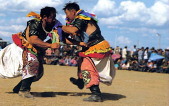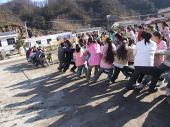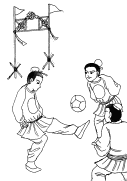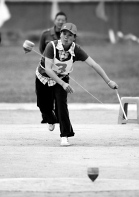China Overview
- Population: 1.3 billion
- Currency: yuan
- Guinness World Records: most people painting each other's faces simultaneously in one location (13,413), largest bottle of cooking oil (containing 3212 litres), most couples hugging (3009 couples).
- Internet users: 135 million
- Milk beer: from Inner Mongolia, an alternative to the traditional mare's-milk wine.
- Squirrel fish: whole mandarin fish deep-fried and manipulated to resemble a squirrel.
- Number of chinese characters: over 56,000
index Land Based Sports and Activities
Land Based Sports and Activities including Chinese wrestling, Tug-of-War, Ancient Chinese Football and top-Spinning are an integral part of Chinese traditional sports and activities. Land Based Sports and Activities were popular in ancient China but also have evolved to worldwide sports events today. | |
What is Chinese wrestling? Chinese wrestling, or Shuai Jiao as it is also know as, shares a long history tracing back to the Huang Di (Emperor Huang). Shuai Chiao training was considered to be the most effective of the Chinese styles, and over many centuries the art was taught to the Imperial Military. It is believed that Chinese wrestling was first practiced on the battlefield more than 5,000 years ago. During the Zhou Dynasty (11th century to 221BC), it was adopted as a fighting art by the government. From the time of the Qin dynasty (221-206BC), Chinese wrestling was more like a recreation than simply for military purposes, and during the Yuan, Ming and Qing dynasties (1271-1911), Chinese wrestling absorbed some techniques of Manchu and Mongolian fighting, and gradually the embryonic form of today's wrestling came into being. |
Shuai Chiao embodies the principles of both Internal and External styles, and the vast majority of martial arts have their roots in Shuai Chiao. Practitioners of Shuai Jiao competed against one another bare-chested, as Shuai Jiao does not depend on the opponent’s clothing in order to throw them.? The priority is to grab the muscle and bone through the clothing
| 
|
in order to control and throw down the opponent.? Fast footwork using sweeps, inner hooks and kicks to the opponent’s leg are combined with the controlling-striking arms that create a two directional action making a powerful throw. |
 | How do you play the Tug-of-War (Bahe)?
In the past, the Tug-of-War was usually held during the Lantern Festival and between two neighboring villages. At one time the rope would be made from bamboo but from the Tang Dynasty (618 - 907) people began to use twine instead. To enable as many people as possible to join in , the main rope often had several branches There could be over one hundred branches tied to |
the main rope , and with the encouragement of beating drums the event would be very exciting. Today the Tug-of-War is popular at sporting events in schools as well as company socials providing an entertaining highlight and considerable good natured amusement. Generally the game is played by having two parallels on the ground as the boundary limit while two teams with equal number of people would stand by each side of the limit holding each end of a rope. Then both sides shall put at full strength upon hearing the order till the other side is pulled out of the boundary. |
How did the Tug-of-War come into being? Tug-of-War originated from the Spring and Autumn Period (about 2400 years ago) in the State of Chu. The Chu State stretched across the Yangtze River with numerous watercourses spreading freely. Besides its land army, it trained a mighty navy and invented a weapon called "Gou Ju" (literally hook and reject) for water battle use. When an enemy force was about to retreat, the soldiers would use the weapon to hook the enemy boats and pull back with all their strength to prevent escape. Later, "Gou Ju" spread from the army to the folk people and gradually evolved to the tug-of-war contest.? Tug-of-war became popular in the folk life in Tang and Song Dynasties. During the years of 712 to 756, the Xuanzong Emperor of Tang once held a tug-of-war contest attended by a thousand people, and both the ordinary people and those in royal palace of the time enjoyed the sport a lot. It was also listed as an event in Olympics held from 1900 to 1920. |
What is ancient Chinese Football and how did it develop? Football has found its way to the most remote corners of the globe, becoming one of the hottest topics of the day. About 2,500 years ago in China there was a similar game called "Cuju’’. ? The ancient Chinese football, also known as Cuju in Chinese is the oldest football game in the world. According to records, "Cu" ("to kick") and "ju" (a type of leather ball filled with feathers) appeared back in the Shang Dynasty (16th century BC - 11th century BC) , and the equipment used was a stone ball which was promoted | 
|
by the army to build up a strong constitution among the soldiers. The ancient Chinese football became most popular during the Warring States Period (476-221BC). In the Han Dynasty (206 BC - 220), it became even more popular and was written into military science of the day. There were no less than 25 versions of the game. It is said that the first emperor of this dynasty Liu Bang was proud of his father who was quite a good ancient football player. In the Southern Song Dynasty (1127 - 1279), when many literary and art works were created on the theme of Cuju, verifying its prosperity, the earliest football club or guild was founded and named 'Yuanshe'. No matter folk or court, city or frontier defense, adults or children, men or women Cuju was well received by all, making it a game which bought the masses together. Although women in feudal times were of a low status and were precluded from many outside occasions, the playground seemed the exception where they could appear in public. Maybe because of the traditional notion of peace and benevolence, Chinese ancient football gradually fell into decline. People, especially the ruling classes, sought to change Cuju which was of competitiveness nature to one for amusement only. Today Cuju has been brought into the sixth China's National Games of Minority Nationality's Traditional Sports. |
 | How is Top-Spinning (Da Tuoluo) played in China?
Top-Spinning which is basically spinning a top using a whip has a long history in China. It is popular among almost all the various groups of people but especially for children. A top excavated in 1926 proves that the game existed 4,000 years ago. A whip is used to spin the top which can be made of pottery, stone, wood or bamboo. While the tops used by children are small and often colorful, those used in competitions are quite different. Tops for formal games usually weigh around 0.45 kilogram (0.99 pound) and the whips are at least 2 meters (6.56 feet) long, verifying its difficulty. |
The cord of the whip is wound round the top that is placed on the ground of a smooth surface which may even be ice. The whip is pulled back causing the top to spin. It is kept spinning and the momentum increased with the aid of the whip. In China this simple pastime has been developed into a competitive sport. Competition rules vary in many ways, and one, often referred to as 'Battling Tops', is where two players tops collide in an effort to cause the opponent's top to fall - the one that stays spinning is the winner. A variation is to get the top to spin over obstacles, requiring great skill and concentration. Again the one who spins the longest time will win the game. |

HOTMost Popular Topics

There is no sincerer love than the love of food.

Because of its size, China has great climatic diversity. Generally, the best time to visit China is during spring and autumn.

Chinese is the most commonly used language in China, and one of the most commonly used languages in the world.

China has many traditional festivals, including the Spring Festival, the Lantern Festival, the Dragon Boat Festival.

In the Chinese zodiac, twelve animals are used to denote the year of a person's birth: rat, ox, tiger, rabbit, dragon.

China, one of the world's most ancient civilizations, has a recorded history of nearly 4,000 years..